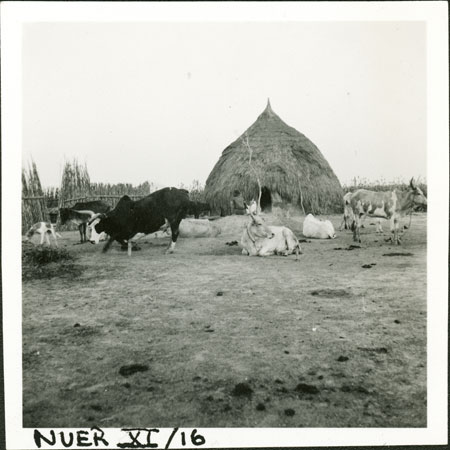Nuer household shrine

58 x 55 mm | Print gelatin silver
There are records relating to alternative images that we do not have scans for in the database:
1998.355.506.1 - Negative film nitrate , (58 x 55 mm )
1998.355.506.1 - Negative film nitrate , (58 x 55 mm )
Condition:
slight Sulphide staining right hand side [7/89 EE]
Date of Print:
Unknown
Previous PRM Number:
EP.N.XI.16
Previous Other Number:
5 [1]
Accession Number:
1998.355.506.2
Description:
A riek or shrine placed in the centre of a homestead consisting of an earthern mound with a forked branch emerging from the summit, upon which someone is seated.
Near the riek are some tethered cattle, and beyond is a beehive-style hut.
The riek post-shrine was considered to be the altar of God within the home, the point of contact between God and spirits (both kwoth) and the lineage or household, and therefore the place of ceremony and sacrifice.
Evans-Pritchard also notes in a related image that the earthen mound is a gol, an area for a fire or smudge, made to help keep away pests such as mosquitos from cattle during the rainy season, and sometimes during the dry season, by enveloping the kraal in thick smoke.
The gol was metaphorically associated with both the home, family and lineage, and the ash was rubbed on cattle before blessing or sacrifice.
Photographer:
Edward Evan Evans-Pritchard
Date of Photo:
1936 October - November
Region:
[Southern Sudan] Wahda
Group:
Nuer ?Dok ?Leek
Notes:
There would seem to be two Rolleiflex films identified as no.
5 in the Nuer series, which I have identified based upon differences in the handwritten style of enumerating the number 5 on the print reverses, as well as on visual content.
[CM 26/10/2007]
PRM Source:
Edward Evan Evans-Pritchard
Acquired:
Donated 1966
Other Owners:
E. E. Evans-Pritchard Collection
Class:
Religion , Shelter , Animal Husbandry , Fire
Keyword:
Shrine , Building House
Documentation:
Original catalogue lists in Manuscript Collections. Additional material in related documents files. [CM 27/9/2005]
Primary Documentation:
Accession Book Entry [p.
98] 1966.27 [1 - 24] G[ift] PROFESSOR E.
E.
EVANS-PRITCHARD; INST.
OF SOCIAL ANTHROPOLOGY, 51 BANBURY RD.
OXFORD 1966.27.1-16 S.
SUDAN.
NUER TRIBE.
Sixteen negative albums containing negatives
and
prints of photographs taken by donor during field-work.
All listed in albums.
Added Accession Book Entry - [p.
98 in right hand column, in pencil] Catalogue room.
Manual Catalogues [index taken from album book XI, ms ink] - 16. kraal
Note on print reverse ms pencil - "5 W. Jik." & print front border ms ink - "NUER XI/16"
Manual Catalogues [index taken from album book XI, ms ink] - 16. kraal
Note on print reverse ms pencil - "5 W. Jik." & print front border ms ink - "NUER XI/16"
Other Information:
In The Nuer (Oxford University Press, 1940) page 114, E.
E.
Evans-Pritchard notes that 'They think then of God looking after their home in a special way, of being particularly attached to it so that he then becomes, as it were, in a special sense the family's God, a household God.
The shrine, a forked post, is the altar of God within the home, God of the hearth, as well as being associated with any of his particular representations-totemic, colwic, air-spirits, &c.-in which he may stand in a tutelary relationship to the lineage or family of the owner of the homestead, and also with the ancestral ghosts.
He is spoken of in this domestic representation as kwoth rieka, God of the post (shrine).' [Chris Morton 2/8/2004]
Recorder:
Christopher Morton [2/8/2004] [Southern Sudan Project]

